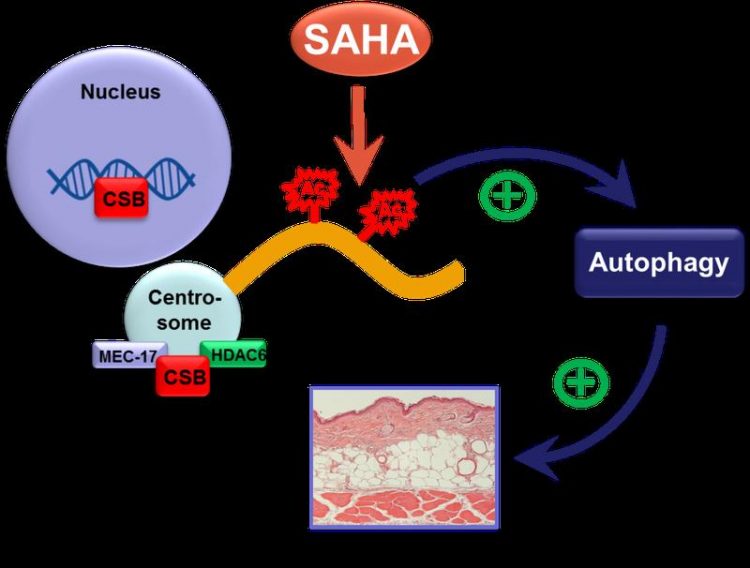More than just a DNA repair deficiency syndrome – impaired acetylation in Cockayne syndrome B

The HDAC inhibitor SAHA rescues the skin phenotype of CSB-deficient mice IUF
The Cockayne syndrome is a very rare hereditary disease, which can lead among others to dwarfism, neurological impairment, premature aging and a shortened life span. Skin symptoms include a striking sensitivity to UV rays and a dramatic loss of subcutaneous fat.
The disease is caused in 80 % of the cases by a mutation in the CSB gene. There is no curative treatment. The CSB protein is well known for its role in DNA repair and the Cockayne syndrome therefore usually described as a DNA repair deficiency syndrome. This view, however, does not explain the diverse clinical phenotype of the patients and hence, the CSB protein most likely serves important biological functions beyond DNA repair.
A study of the IUF – Leibniz Research Institute for Environmental Medicine and the Heinrich Heine University Düsseldorf (HHU), Germany, now shows for the first time that the CSB protein is not only present in the nucleus but also at the centrosome of the cell where it enhances acetylation (a certain modification) of α-Tubulin (a protein which forms routes of transportation in the cell) and thereby regulates autophagy (the degradation of cellular material in the cell fluid).
If the protein is not able to fulfill this task, an imbalance in protein acetylation occurs. Administration of the histone deacetylase inhibitor SAHA, which inhibits a certain protein family in reversing acetylation, was able to restore this balance. Of note, the loss of subcutaneous fat, i.e. a hallmark of Cockayne syndrome B, could also be restored by SAHA in the mouse model.
These results, which have been generated across several species including nematodes, mice and human skin cells, were now published in “Science Translational Medicine”. Future studies will assess if the HDAC inhibitor SAHA, which is a FDA approved drug for treating certain forms of cutaneous T cell lymphoma, is also suitable for the treatment of patients with Cockayne syndrome.
“More and more biological functions beyond DNA repair are being discovered for proteins, which were originally described as DNA repair enzymes. Examples are the CSB protein but also the XPA protein which causes a very severe subtype of Xeroderma pigmentosum”, says Prof. Jean Krutmann, director of the IUF. “This paradigm shift might allow us to identify new strategies for the treatment of these incurable diseases”.
The investigations with the nematodes were conducted by a liaison group between the IUF and the Central Institute of Clinical Chemistry and Laboratory Medicine of the Heinrich Heine University in Düsseldorf, Germany, which is led by Dr. Natascia Ventura.
About the IUF
The IUF – Leibniz Research Institute for Environmental Medicine investigates the molecular mechanisms through which particles, radiation and environmental chemicals harm human health. The main working areas are environmentally induced aging of the cardiopulmonary system and the skin as well as disturbances of the nervous and immune system. Through development of novel model systems the IUF contributes to the improvement of risk assessment and the identification of novel strategies for the prevention / therapy of environmentally induced health damage.
More information: http://www.iuf-duesseldorf.com.
The IUF is part of the Leibniz Association: http://www.leibniz-gemeinschaft.de/en/home.
Contact
Christiane Klasen, Personal Assistant to the institute’s Director
IUF – Leibniz Research Institute for Environmental Medicine
Auf’m Hennekamp 50
40225 Düsseldorf
Germany
Email: Christiane.Klasen@IUF-Duesseldorf.de
Phone: +49 (0)211 3389 216
Majora M, Sondenheimer K, Knechten M, Uthe I, Esser C, Schiavi A, Ventura N, Krutmann J: HDAC inhibition improves autophagic and lysosomal function to prevent loss of subcutaneous fat in a mouse model of Cockayne syndrome. Sci Transl Med 10: eaam7510, 2018. doi: 10.1126/scitranslmed.aam7510
https://www.doi.org/10.1126/scitranslmed.aam7510
Media Contact
More Information:
http://www.iuf-duesseldorf.deAll latest news from the category: Life Sciences and Chemistry
Articles and reports from the Life Sciences and chemistry area deal with applied and basic research into modern biology, chemistry and human medicine.
Valuable information can be found on a range of life sciences fields including bacteriology, biochemistry, bionics, bioinformatics, biophysics, biotechnology, genetics, geobotany, human biology, marine biology, microbiology, molecular biology, cellular biology, zoology, bioinorganic chemistry, microchemistry and environmental chemistry.
Newest articles

First-of-its-kind study uses remote sensing to monitor plastic debris in rivers and lakes
Remote sensing creates a cost-effective solution to monitoring plastic pollution. A first-of-its-kind study from researchers at the University of Minnesota Twin Cities shows how remote sensing can help monitor and…

Laser-based artificial neuron mimics nerve cell functions at lightning speed
With a processing speed a billion times faster than nature, chip-based laser neuron could help advance AI tasks such as pattern recognition and sequence prediction. Researchers have developed a laser-based…

Optimising the processing of plastic waste
Just one look in the yellow bin reveals a colourful jumble of different types of plastic. However, the purer and more uniform plastic waste is, the easier it is to…



